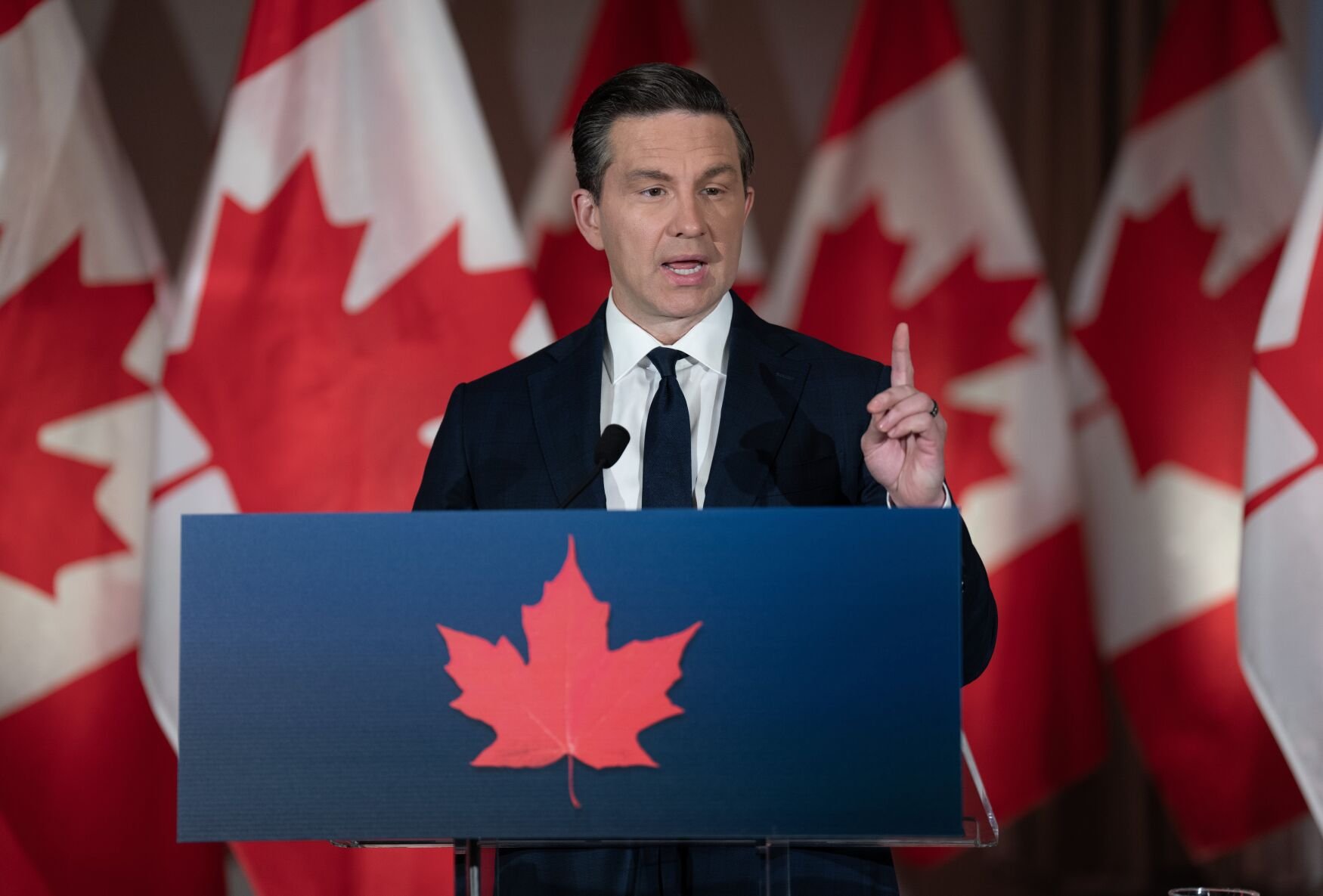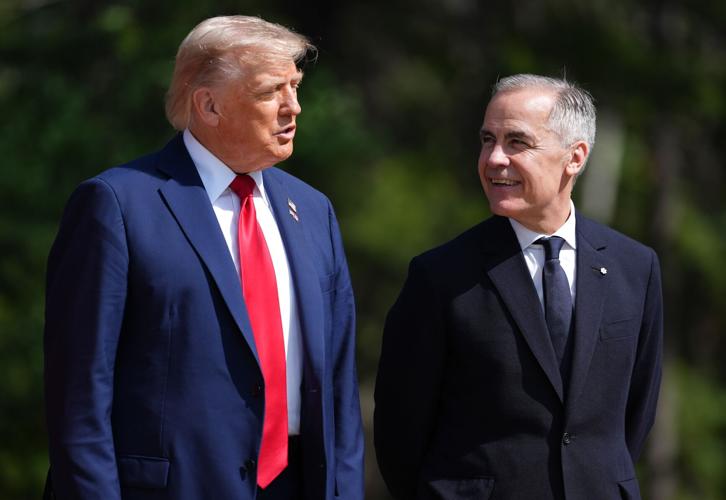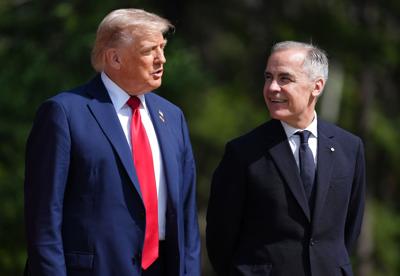U.S. President Donald Trump╠²signed an executive order to hike tariffs after Canada and the U.S. failed to reach a trade deal by his Aug. 1 deadline. Follow the Star’s live coverage below.
In wake of bad jobs report, Trump wants to fire head of labour statistics department

President Donald Trump listens during an event to sign an executive order restarting the Presidential Fitness Test in public schools, Thursday, July 31, 2025, in the Roosevelt Room of the White House in Washington.
Jacquelyn Martin/AP PhotoTrump said on Truth Social that he will remove Erika McEntarfer as the commissioner of labor statistics after the July employment report found that just 73,000 jobs were added in July and hiring in June and May was revised downward by 258,000 jobs combined.
Trump said that McEntarfer is a ŌĆ£Biden Political AppointeeŌĆØ as he questioned the accuracy of the numbers.
ŌĆ£She will be replaced with someone much more competent and qualified,ŌĆØ Trump said. ŌĆ£Important numbers like this must be fair and accurate, they canŌĆÖt be manipulated for political purposes.ŌĆØ
The comments were TrumpŌĆÖs first public remarks on the jobs report released Friday.
Canadian party leaders react

Conservative Leader Pierre Poilievre is seen during a news conference in Ottawa on Monday, July 14, 2025.
Adrian Wyld/The Canadian PressCanada’s Conservative and NDP leaders chimed in with calls to action Friday afternoon on the heels of the missed trade deadline.
“Conservatives share Canadians’ disappointment that a deal with the United States was not reached by the August 1st deadline,” Conservative Leader Pierre Poilievre , calling Trump’s tariffs “deeply misguided policies (that) will hurt families and businesses on both sides of the border.”
Poilievre called on Carney’s government to cut taxes on energy and home-building and repeal what the Conservative Leader called “anti-development laws.”
Carney “gave in on key issues” amid tariff talks but still could not achieve a deal in time, NDP Leader Don Davies chided , pointing to the scrapped digital services tax and the controversial Bill C-2. “Mr. Carney knew his strategy was failing. He hinted at a missed deadline days ago - and now itŌĆÖs happened.”
Davies urged the Liberals to invest in domestic manufacturing and union jobs, stop cuts to Canadian public services and speed up trade diversification with Europe and Asia, among other demands.
Premiers Smith, Moe disappointed by TrumpŌĆÖs tariffs
REGINA - The premiers of Alberta and Saskatchewan say theyŌĆÖre disappointed by higher tariffs from U.S. President Donald Trump but pleased the majority of their exports wonŌĆÖt face duties.
Saskatchewan Premier Scott Moe says the Canada-United States-Mexico trade agreement remains in place, allowing 95 per cent of his provinceŌĆÖs exports to move into the United States tariff-free.
He says the agreement staying in effect is very significant and provides Canada with an advantage over other countries facing steeper levies.
Alberta Premier Danielle Smith says the vast majority of her provinceŌĆÖs products also remain tariff-free, because they also fall under the agreement.
Questions swirl around the tariffs despite TrumpŌĆÖs eagerness

U.S. President Donald Trump speaks in the East Room of the White House, Wednesday, July 30, 2025, in Washington.╠²
Mark Schiefelbein / The Associated PressAs the clock ticked toward TrumpŌĆÖs self-imposed deadline, few things seemed to be settled other than the presidentŌĆÖs determination to levy the taxes he has talked about for decades.
The very legality of the tariffs remains an open question as a U.S. appeals court on Thursday heard arguments on whether Trump had exceeded his authority by declaring an ŌĆ£emergencyŌĆØ under a 1977 law to charge the tariffs, allowing him to avoid congressional approval.
Attorney General Dan Rayfield of Oregon, one of the states that filed suit, asserted that the judges ŌĆ£didnŌĆÖt buyŌĆÖŌĆÖ the Trump administrationŌĆÖs arguments.
Wall Street woes
Stocks slumped in morning trading on Wall Street Friday and Treasury yields fell sharply after the government reported a sharp slowdown in hiring last month.
Markets are also reacting to the latest tariff news. The S&P 500 fell 1.5%, on track to close the week with a loss. The Dow Jones Industrial Average fell 599 points, or 1.4% as of 9:44 a.m. Eastern. The Nasdaq composite fell 2%.
Worries on Wall Street about a weakening economy were heavily reinforced by FridayŌĆÖs sharply-lower-than-expected report on U.S. job growth.
S&P/TSX composite falls along with global markets as new U.S. tariffs take effect

A person walks past the TMX Market Centre in ╬┌č╗┤½├Į, Wednesday, Sept. 11, 2024.
Paige Taylor White/The Canadian PressCanada’s main stock index was down Friday along with global markets as U.S. President Donald Trump imposed new tariffs on numerous countries and U.S. job numbers showed signs of weakness.
The S&P/TSX composite index was down 257.11 points at 27,002.67 in broad losses led by energy.
In New York, the Dow Jones industrial average was down 575.39 points at 43,555.59. The S&P 500 index was down 101.80 points at 6,237.59, while the Nasdaq composite was down 449.11 points at 20,673.34.
No trade deal with U.S. better than a bad one: Canadian business groups
Canadian business groups anxiously watching trade negotiations with the U.S. don’t want the country to rush into a deal but say the uncertainty is weighing on their members.
The Canadian Chamber of Commerce says it feels spending a little bit more time on crafting the right deal is well worth the wait because it will deliver lasting benefits.
However, the group also feels businesses in Canada and the U.S. urgently need more certainty.
What is CUSMA compliance?
The Canada-U.S.-Mexico Agreement (CUSMA) was negotiated during the first Trump administration to replace the North American Free Trade Agreement.
Companies can claim preferential treatment under CUSMA if they meet its rules of origin. While it is different depending on the product, generally it requires a specific amount of the goods be made of products or with labour originating from Canada, Mexico or the United States.
About 80 to 90 per cent of Canadian goods might be able to comply with CUSMAŌĆÖs rules of origin, said Michael Dobner, the national leader of economics and policy practice at PricewaterhouseCoopers Canada.
Prime Minister Mark Carney responds

Prime Minister Mark Carney speaks with media during a news conference in Ottawa, Wednesday, July 30, 2025.
Adrian Wyld/The Canadian PressPrime Minister Mark Carney released a statement just past midnight on Friday after U.S. President Donald Trump imposed a 35 per cent tariff on Canadian goods.
On Thursday, Trump declared the rate hike on products that donŌĆÖt comply with the Canada-U.S.-Mexico Agreement (CUSMA).
“While the Canadian government is disappointed by this action, we remain committed to CUMSA, which is the world’s second-largest free trade agreement by trading volume,” Carney’s statement read.
“The U.S. application of CUSMA means that the U.S. average tariff rate on Canadian goods remains one of its lowest for all of its trading partners. Other sectors of our economy ŌĆö including lumber, steel, aluminum and automobiles ŌĆö are, however, heavily impacted by U.S. duties and tariffs.”
╠²
Carney might become a lying traitor or noble change agent. But how will we know which?

Canadian Foreign Affairs Minister Anita Anand listens to Canadian Prime Minister Mark Carney speak during a press conference after a cabinet meeting to discuss both trade negotiations with the U.S. and the situation in the Middle East, at the National Press Theatre in Ottawa on Wednesday.
DAVE CHAN AFP via Getty ImagesDeadlines arenŌĆÖt what they used to be. We donŌĆÖt yet know (as I write this, Thursday) what todayŌĆÖs will bring but Trump has already said our tentative recognition of Palestine could make a trade resolution impossible.
What next? He demands, for reasons too obvious to state, ? Instead, letŌĆÖs focus on our guy, Prime Minister Mark Carney.
He is either a lying hypocritical traitor or a noble change agent. The problem is less knowing which than knowing when we finally know.
During his leadership run and election, he said Trump wants to break us so they can own us and that wonŌĆÖt happen. Ne ŌĆ” ver.
But lately heŌĆÖs said we need to live with their arbitrary tariffs and pay them imperial tributes by buying whatever they say. That doesnŌĆÖt sound very proud and independent. In Brazil there were street celebrations for refusing to bend the knee to the U.S.
This makes Carney sound rather neo-liberal: let the free markets rule as in 19th╠²century economics, which really means whoever has the money, sets the rules but donŌĆÖt worry, it will work out for everyone.
The only neo thing about neo-liberalism is it came after a long interregnum of Keynesian government interventionism, to which Carney had seemed sympathetic. On the other hand, heŌĆÖs a youthful 60 and as an adult has only served neo-liberal regimes like Stephen HarperŌĆÖs and the U.K. Tories. He knows their inadequacies well yet must feel a bit disoriented trying to head off in a very different direction.
So, we truly donŌĆÖt know. His buy-in to a huge bump in military spending under U.S. pressure was ominous.
Yet, consider the two main thrusts of his cave.
One is building up the navy. After the Second World, Canada had the worldŌĆÖs third largest merchant fleet. Yet, its owners and our government destroyed it by selling it off and smashing the heroic Canadian Merchant SeamenŌĆÖs Union through importing a crime-ridden U.S. union. (ItŌĆÖs described in Elaine BriereŌĆÖs heartbreaking documentary, “Betrayed.”) CarneyŌĆÖs policy could amount to “dual use,” restoring our civilian shipbuilding capacity.
The other thrust is aerospace. This recalls the destruction of the Avro Arrow program in the 1950s and obliteration of Canadian success in aerospace projects. Does Carney intend to reverse these drifts?
I donŌĆÖt mean to suggest he knows which side heŌĆÖs on. ThatŌĆÖs possible but pretty rare; politics doesnŌĆÖt work like that normally. Politicians find out who they are and what theyŌĆÖre going to do when they do it. (U.S. President Barack ObamaŌĆÖs disgraceful choice in 2008 to rescue banks but let homeowners fail is a good ŌĆö well, awful ŌĆö example.)
What you believe doesnŌĆÖt define you, itŌĆÖs what you do that does.
This brings us to the key deficiency in CarneyŌĆÖs arsenal: the absence of a constituency he can resort to for advice, useful defiance, or support. The Conservatives have their base, who generally push in a neo-liberal direction. So they tend to reflexively dismantle whatever good a previous government did.
The NDP, to the extent they still exist, have a union base plus various progressive streams.
The Liberals, as usual, are an unimpressive muddle. ItŌĆÖs a wonder they survive, though it may also be their secret ingredient. But in a crisis like this, they can neither hold a leader accountable nor have his back.
This puts us ŌĆö and I say this with all the confidence of someone about to kick a hornetsŌĆÖ nest ŌĆö eerily in the situation of Cuba when the U.S. imposed its blockade decades ago. Their natural trading partner was gone with the wind and desperate to survive without bowing to the U.S. will and restoring its hideous suzerainty, they turned to the Soviet Union. Castro had been a progressive nationalist and revolutionary but hardly a Marxist-Leninist.
ThatŌĆÖs obviously not where Carney is headed. But he does recall the amiable figure Robert Redford played in “The Candidate,” who unexpectedly wins and turns to his brilliant campaign manager asking what we do now. Neither of them has a clue.
Donald Trump signs executive order hiking tariffs to 35% on some Canadian goods

U.S. President Donald Trump speaks at the White House, in Washington, on July 30, 2025.
Mark Schiefelbein/The Associated PressOTTAWA ŌĆö U.S. President Donald Trump signed an executive order late Thursday hiking tariffs on certain Canadian goods to 35 per cent, with no deal materializing between Ottawa and Washington as the clock ticked towards an Aug. 1 deadline to reach a trade agreement.
A fact sheet issued by the White House confirms that tariffs on Canadian goods that don’t comply╠²with the Canada-U.S.-Mexico Agreement (CUSMA) will jump from 25 per cent to the 35 per cent Trump threatened to impose earlier in July, if Canada failed to take further action on halting the flow of fentanyl across the border.
Most Canadian goods meet the terms dictated by CUSMA, meaning they are not hit by the tariffs, which are separate from those targeting specific sectors.
“Shortly after returning to office, President Trump declared a national emergency under the International Emergency Economic Powers Act (IEEPA) to address, among other things, the public health crisis caused by fentanyl and illicit drugs flowing across the northern border into the United States,” Thursday’s fact sheet noted.
“Canada has failed to co-operate in curbing the ongoing flood of fentanyl and other illicit drugs, and it has retaliated against the United States for the PresidentŌĆÖs actions to address this unusual and extraordinary threat to the United States.”
In response, the fact sheet said, Trump “found it necessary” to boost the tariffs.
Prime Minister Mark Carney has yet to respond to the hike, but the federal government has already introduced legislation partly aimed at stopping the cross-border flow of illicit substances, appointed a “fentanyl czar” to curb the production and trafficking of the synthetic opioid, and mounted a $1.3-billion border plan to address the issue. While Trump claimed at the onset of the months-long trade dispute that illegal drugs were “pouring” across its northern border, only a very minor amount of the fentanyl smuggled into the U.S. originates from Canada.
Premier Doug Ford said on X that Ottawa should “hit back” with a 50 per cent levy on U.S. steel and aluminum.╠²
“The increase in U.S. tariffs to 35 per cent is concerning, especially with tariffs still in place on steel, aluminum, autos, forestry and now copper. While Canada continues to benefit from zero tariffs on all trade thatŌĆÖs USMCA compliant, representing over 90 per cent of our American exports, we need to do everything in our power to protect workers, businesses and communities from the impact of tariffs,”
Earlier in the day, White╠²House Press Secretary Karoline Leavitt suggested Trump could still cut deals with countries that had not yet reached agreements by midnight.
“I do know foreign leaders are ringing his phone, realizing this deadline is a real thing for them tomorrow, and they’re bringing offers to the table,” she said.
That prospect appeared increasingly dim for Canada╠²as the day wore on, with Dominic LeBlanc, CarneyŌĆÖs cabinet lead on Canada-U.S. trade, CarneyŌĆÖs chief of staff Marc-Andr├® Blanchard, and Kirsten Hillman, CanadaŌĆÖs ambassador to the U.S., holed up in Washington to seek out a deal.╠²On Wednesday, Carney signalled it was possible negotiations would extend beyond the deadline, and called the talks “constructive” and “complex.”
Trump said Thursday that where Mexico was concerned, he had initiated a 90-day negotiating period following a call with Mexican President Claudia Sheinbaum, and that Mexican imports would continue to be subject to a 25 per cent tariff, along with a 25 per cent tariff on autos and a 50 per cent tariff on steel, aluminum and copper.
But the gulf between Canada and its largest trading partner appeared to widen early Thursday morning, when Trump warned that Canada’s plan to recognize a state of Palestine had with Ottawa on the eve of his deadline.
By Thursday afternoon, Trump had softened his tone, telling reporters in Washington that while he “didn’t like” Canada’s decision, the move was “not a deal-breaker.”
“We haven’t spoken to Canada today. He’s called and we’ll see,” Trump said, appearing to refer to Carney.╠²
When asked what the holdup was with arriving at a deal with Ottawa, the president said Canada has been “treating our country very badly for years.”
“I love Canada, have so many friends in Canada, but they’ve been very poorly led. They’ve been very, very poorly led, and all we want is fairness for our country,” Trump said.
Carney said Wednesday that Canada intends to recognize a Palestinian state in September, a pledge that is contingent on the Palestinian Authority, the governing body in the occupied West Bank, agreeing to a series of democratic reforms. The reforms include holding general elections in 2026, in which Hamas can have no role, and ensuring that a Palestinian state is demilitarized. The prime minister said Palestinian Authority President Mahmoud Abbas had agreed to the conditions.
The announcement, which followed similar declarations from France and the United Kingdom, deepened the divide between Canada and Trump, a key ally to Israel.
TrumpŌĆÖs penchant for throwing last-minute wrenches into the works ŌĆö particularly when theyŌĆÖre not trade-related ŌĆö is unprecedented, said veteran trade lawyer John Boscariol.
ŌĆ£Trump is not using tariffs strictly for trade purposes but instead to achieve all these other objectives, and he moves the goalposts,ŌĆØ said Boscariol, head of the trade law group at the law firm McCarthy Tetrault.
TrumpŌĆÖs late-night musing about CanadaŌĆÖs potential recognition of a Palestinian state was reminiscent of his reference to the prosecution of former Brazilian president Jair Bolsonaro in his tariff letter to Brazil.
ŌĆ£This makes it much more challenging for CanadaŌĆÖs negotiators,ŌĆØ Boscariol said, warning that just because Mexico got an extension of the Aug. 1 deadline doesnŌĆÖt mean Canada will.
Flavio Volpe, the head of Canada’s Automotive Parts Manufacturers’ Association, said Thursday night he is still working with “Canadian negotiators on getting the best deal for domestic interests.” He added that the tariff increase “on a fabricated emergency premise continues to offend the interests of both Canadian and American companies trying to stay competitive against a rising Chinese hegemony.”
The president of the Canadian Chamber of Commerce, Candace Laing, called the White House’s fact sheet a “fact-less sheet.”
“The Carney government is right to prioritize a strong, future-focused deal over a rushed one,” Laing said in a statement.
“In the meantime, we have CUSMA, which, at present, is still being honoured, leaving much of our cross-border trade tariff-free. However, not all Canadian businesses have this advantage and the jump to 35% tariffs on non-CUSMA compliant products places an additional load on them.”
Earlier in the day, Catherine Cobden, CEO of the Canadian Steel Producers Association,╠²urged negotiators to push back on the hefty tariffs on steel imports, which have already led to job losses and production slowdowns in the country.
ŌĆ£Hold the line. Don’t accept 50 per cent,” Cobden said.╠²
CanadaŌĆÖs aluminum industry is also coping with the impact of 50-per-cent tariffs, and is still hopeful a deal can be reached to see them lowered.
When that will happen, however, is another matter, said Jean Simard, CEO of the Aluminum Association of Canada.
ŌĆ£ItŌĆÖs impossible truly to have a deal in time for Aug. 1,ŌĆØ said Simard. ŌĆ£WhatŌĆÖs left is either putting tariffs in, or pushing the deadline. And I think pushing the deadline is easier.ŌĆØ
With files from Mark Ramzy and Alex Ballingall
How did we get here? A look back at Trump's trade war
Here's a look at how Trump's trade war has unfolded with Canada over the past few months. (July 27, 2025)
Error! Sorry, there was an error processing your request.
There was a problem with the recaptcha. Please try again.
You may unsubscribe at any time. By signing up, you agree to our and . This site is protected by reCAPTCHA and the Google and apply.
Want more of the latest from us? Sign up for more at our newsletter page.




























To join the conversation set a first and last name in your user profile.
Sign in or register for free to join the Conversation